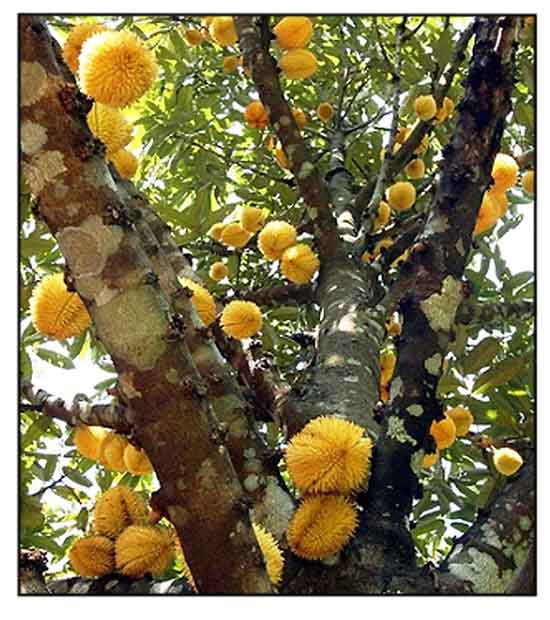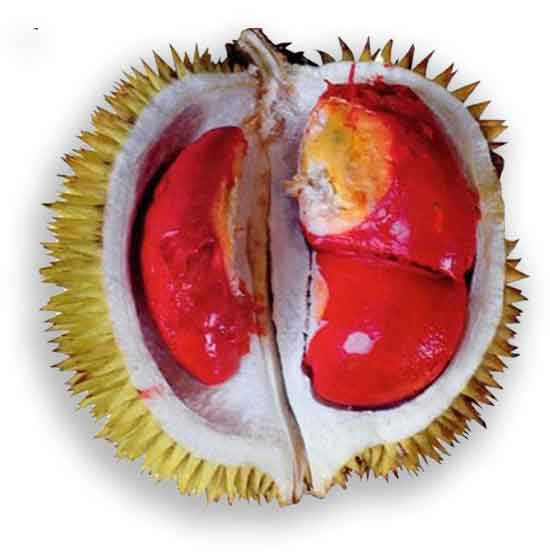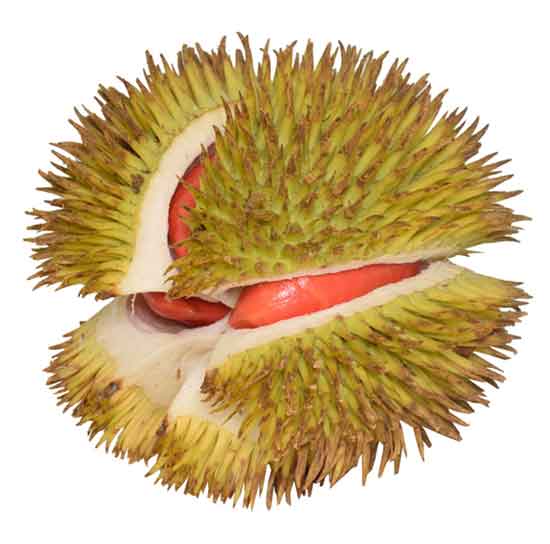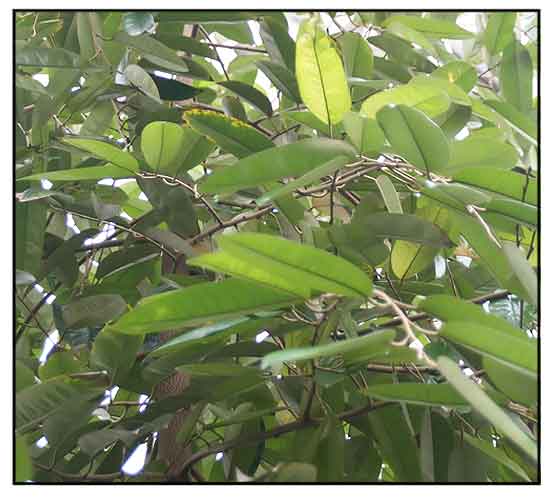 Gen info Gen info
- Durio graveolens is a species of tree in the family Malvaceae. It is one of six species of durian named by Italian naturalist Odoardo Beccari.
- Durio sensu lato has 30 recognized species. Durio sensu stricto comprises 24 of these species. (7)
- Etymology: The genus name Durio derives from durian or durion, which is the Malay vernacular name for the thorny fruit of the plant and where duri means thorn. The specific epithet graveolens derives from Latin gravis meaning "heavy, strong" and olens meaning "smell" referring to the fruit's strong smell or rank odor. (3)
- While most Durio species, especially Durio dulcis, have a strong scent, the red-fleshed D. graveolens has a mild scent.
A book published by the U.S. National Research Council referred to it as "odorless". (6)
- D. graveolens is the most popular 'wild" species of durian; however, its cogener D. zibethinus is the most commonly eaten species and dominates sales worldwide. (6)
- The synonym journey: The plant has journeyed through various synonyms. It was initially described in 1889 by Odoardo Beccari. In 1924, Dutch botanist Reinier Cornelius Bakhuizen Van den Brink reduced it to a synonym of D. conicus. In 1953 British botanist John Wyatt-Smith combined it under D. dulcis. In 1958, Indonesian botanists Andre Joseph Guillaume Henri Kostermans and Wertit Soegeng-Reksodihardjo separated D. graveolens back to its own species in 1958. (6)
- Red Durio graveolens should not be confused for popular clones from Malaysia known as Red Flesh (D164) and Red Prawn (D175), both belonging to D. zibethinus. (6)
 Botany Botany
- D. graveolens is a large tree that can reach up to measure 50 m tall, with straight, cylindrical bole, branchless for up to measure 25 m and up to measure 100 cm in diameter and with steep buttresses that up to 3 m high. The bark surface is smooth, finely cracked or flaky, reddish-brown or grayish-mauve in color. The leaves are elliptical to oblong in shape, measuring 10-26 cm x 4-10 cm and densely copper-brown scaly below. The flowers are in short cymes on branches. The white petals are measure about 25-35 mm long. The stamens are in 5 bundles and opened by a slit. The fruit is spherical, up to measure 15 cm in diameter where the outside is orange-yellow in color with sharp pyramidal spines. (2)
• D. graveolens is a large tree, sharing many features with D. dulcis. It inhabits the upper canopy, growing up to 50 m (160 ft) tall. Trunk is 85–100 cm (33–39 in) in diameter and can have no branches until about 25 m (82 ft) high. Trunk is smooth or flaky, gray/mauve to ruddy brown with steep buttress roots. Buttresses reach 3 m (9.8 ft) and extend out 1.5 m (4 ft 11 in). Leaves are oblong, 10–26 cm (3.9–10.2 in) long without the petiole (leaf stalk), and 4–10 cm (1.6–3.9 in) wide, perfectly rounded on both ends, rigid, and slightly coriaceous (leather-like in feel or texture), glabrous on the top (smooth and hairless) and crisp, almost vernicose (varnished). Leaves are copper-brown and lepidote (scaly) underneath, with large scales of up to 2 mm (0.079 in) in diameter, which are not very noticeable, at least when dry. Leaf scales are peltate (shield-shaped), ciliate-radiated (fringed), and deeply-lobed in three to five parts. In addition to the scales, long strands of stellate hairs and other trichomes of varying size form a soft tomentose (fuzzy) surface. Leaf midrib is very prominent on the underside and forms a crease on top. Leaf stipules are caducous (drop early). Leaves have 10-12 lateral veins per side (with some smaller ones intermixed), which are tiny and superficial above and more distinct, but still barely visible. Petiole is very large, 15–18 mm (0.59–0.71 in) long, and  tumescent (swollen) from the middle up. Flowers grow on the branches on short cymes and a thin calyx. Base is sac-like with three to five connate lobes. Petals are white, spatulate (spoon-shaped), 25–35 millimeters (0.98–1.38 in) long. Inside are five separate bundles of staminodes and stamens, fused for less than half of their length. Anther has small clusters of four or five elongated pollen locules that open with longitudinal slits. Ovaries are ovoid to globose (roughly spherical) and possess a yellow capitate (shaped like a pinhead) stigma and white to greenish style about 48 mm (1.9 in). Pollen is psilate (relatively smooth), spheroidal, and 54 μm (0.0021 in) in diameter. The surface of the pollen includes three colporate apertures, meaning the apertures have a combined colpus (or furrow) and pore. The pollen grains are monad and do not cluster. Fruits are up to 10–15 cm (3.9–5.9 in) in diameter, and weigh about 757.5 grams (26.72 oz). The greenish- to orange-yellow outside is densely covered with long (1 cm (0.39 in)) and thin angular-subulate spines which are straight or slightly curved, and prickly yet slightly soft. Fruit easily breaks into five fibrous-coriaceous valves with 5–6 millimeters (0.20–0.24 in) thick walls. Typically the fruit opens on the tree, but some varieties do not until they are on the ground or harvested. There are 2 bulbous or chestnut-shaped seeds per section, each completely enveloped by fleshy aril. These glossy brown seeds are 2 cm × 4 cm (0.79 in × 1.57 in). The pungent aril is the part consumed as food, though some sources note the odor is sometimes very mild. It ranges in color from light yellow to orange to lipstick red. (6) tumescent (swollen) from the middle up. Flowers grow on the branches on short cymes and a thin calyx. Base is sac-like with three to five connate lobes. Petals are white, spatulate (spoon-shaped), 25–35 millimeters (0.98–1.38 in) long. Inside are five separate bundles of staminodes and stamens, fused for less than half of their length. Anther has small clusters of four or five elongated pollen locules that open with longitudinal slits. Ovaries are ovoid to globose (roughly spherical) and possess a yellow capitate (shaped like a pinhead) stigma and white to greenish style about 48 mm (1.9 in). Pollen is psilate (relatively smooth), spheroidal, and 54 μm (0.0021 in) in diameter. The surface of the pollen includes three colporate apertures, meaning the apertures have a combined colpus (or furrow) and pore. The pollen grains are monad and do not cluster. Fruits are up to 10–15 cm (3.9–5.9 in) in diameter, and weigh about 757.5 grams (26.72 oz). The greenish- to orange-yellow outside is densely covered with long (1 cm (0.39 in)) and thin angular-subulate spines which are straight or slightly curved, and prickly yet slightly soft. Fruit easily breaks into five fibrous-coriaceous valves with 5–6 millimeters (0.20–0.24 in) thick walls. Typically the fruit opens on the tree, but some varieties do not until they are on the ground or harvested. There are 2 bulbous or chestnut-shaped seeds per section, each completely enveloped by fleshy aril. These glossy brown seeds are 2 cm × 4 cm (0.79 in × 1.57 in). The pungent aril is the part consumed as food, though some sources note the odor is sometimes very mild. It ranges in color from light yellow to orange to lipstick red. (6)
Distribution
- Introduced. (?)
- In lowland forests up to 1000 m altitude. In Sarawak, on clay soils in mixed dipterocarp forest and on shale ridges.
- Native to Borneo, Malaya, Sumatera, Thailand.
- IUCN Red listed as "vulnerable".
 Constituents Constituents
- Proximate and fatty acid composition of yellow durian (Durio graveolens Becc.) yielded 66.5% moisture, 3.1% protein, 5.5% fat, 1.1% ash, 3.7% crude fiber, and 20.2% carbohydrate. Thirteen fatty acids were detected with saturated fatty acids at 30.3% and unsaturated fatty acids at 69.7%. Highest saturated fatty acid was myristic acid (14.52%), the lowest was lauric acid (1.3%). For unsaturated fatty acids, highest was oleic acid at 22.2%, lowest was myristoleic acid at 1.9%. (5)
- Saturated fats include myristic acid (14.49%), arachidic acid
(7.08%), pentadecanoic acid (3.61%), heptadecanoic acid (2.2%), decanoic acid (1.62%), and lauric acid (1.31%). Unsaturated fats include oleic acid (22.18%), palmitoleic acid (13.55%), linolelaidic acid (12.39%), γ-linoleic acid (12.23%). linoleic acid (4.95%), elaidic acid (2.50%), and myristoleic acid (1.89%). (3)
- Nutritional value per 100 g of fruit: Energy 152 kcal (640 kJ); Carbohydrates:
Dietary fiber 21.5g; Fat: 6.2 g, saturated 1.9 g, trans 0.9 g, monosaturated 2.5 g, polyunsaturated 1.8 g; Protein 2.6g; Vitamin C 10.4 mg; Minerals: calcium 10 mg, copper 0.7 mg, iron 0.6 mg, magnesium 27 mg, manganese 0.4 mg, phosphorus 43 mg, potassium 529 mg (11% DV), zinc 0.59 mg; Water 66.7%, cholesterol 0 mg. (Source: Hoe & Siong 1999; Nasaruddin, Noor, & Mamat 2013) (8)
Caution!
• High Potassium Content: As a potassium-rich
food it could be a good fruit to supplement potassium needs of
patients on diuretic therapy. However, it's potassium content should
be of concern in patients with kidney failure or varying degrees of
renal impairment or those already taking other forms of potassium supplementation
or potassium-sparing diuretics.
Uses
Edibility
- Sweet pulp is eaten raw. Aril around the seed is edible, though not very juicy, hardly fragrant, and not very tasty. Unlike other durians, the aril is free of odor, or emitting a fragrance of roasted almonds.
- Fruit is used for seasoning and in soups. It is sometimes, fermented in tempoyak seasoning.
The red-fleshed variety used with freshwater fish to make a type of sayur (a traditional Indonesian vegetable stew). (3)
- Seeds can be ground into flour (dalit tepung biji durian), which can be used to make fish crackers. (3)
Folkloric
- In Iban, mature bark decoction used for bathing day-old infants, which is believed to strengthen the skin, especially those from early (premature) births. (3)
Others
- Timber: Wood is durable; used in light and interior construction, for making furniture components, packing cases, veneer and plywood. Heartwood is pink-brown, red, or deep red-brown. Not resistance to termites. (1)
- Customs and beliefs: Myths are shared by various species of durian: Durian is harmful when eaten along with coffee or alcoholic beverages. (see: Durian with alcohol: Disulfiram-ethanol-like reaction) Alcohol after durian can cause indigestion or bad breath. Studies have shown varying conclusions. (2) Javanese believe the fruit has aphrodisiac qualities. Warnings have been sounded on its erotic and lecherous potential. (3) In Indonesia, getting a fallen durian means receiving unexpected luck or good fortune.
Studies
• Proximate and Fatty Acid Composition: See constituents above.
•
No other studies found specific for D. graveolens: See studies on Durian (Durio zibethinus).
Availability
- Wildcrafted.
-
Cultivated.
- Seeds almost impossible to obtain outside of habitat. |

![]()





 tumescent (swollen) from the middle up. Flowers grow on the branches on short cymes and a thin calyx. Base is sac-like with three to five connate lobes. Petals are white, spatulate (spoon-shaped), 25–35 millimeters (0.98–1.38 in) long. Inside are five separate bundles of staminodes and stamens, fused for less than half of their length. Anther has small clusters of four or five elongated pollen locules that open with longitudinal slits. Ovaries are ovoid to globose (roughly spherical) and possess a yellow capitate (shaped like a pinhead) stigma and white to greenish style about 48 mm (1.9 in). Pollen is psilate (relatively smooth), spheroidal, and 54 μm (0.0021 in) in diameter. The surface of the pollen includes three colporate apertures, meaning the apertures have a combined colpus (or furrow) and pore. The pollen grains are monad and do not cluster. Fruits are up to 10–15 cm (3.9–5.9 in) in diameter, and weigh about 757.5 grams (26.72 oz). The greenish- to orange-yellow outside is densely covered with long (1 cm (0.39 in)) and thin angular-subulate spines which are straight or slightly curved, and prickly yet slightly soft. Fruit easily breaks into five fibrous-coriaceous valves with 5–6 millimeters (0.20–0.24 in) thick walls. Typically the fruit opens on the tree, but some varieties do not until they are on the ground or harvested. There are 2 bulbous or chestnut-shaped seeds per section, each completely enveloped by fleshy aril. These glossy brown seeds are 2 cm × 4 cm (0.79 in × 1.57 in). The pungent aril is the part consumed as food, though some sources note the odor is sometimes very mild. It ranges in color from light yellow to orange to lipstick red. (
tumescent (swollen) from the middle up. Flowers grow on the branches on short cymes and a thin calyx. Base is sac-like with three to five connate lobes. Petals are white, spatulate (spoon-shaped), 25–35 millimeters (0.98–1.38 in) long. Inside are five separate bundles of staminodes and stamens, fused for less than half of their length. Anther has small clusters of four or five elongated pollen locules that open with longitudinal slits. Ovaries are ovoid to globose (roughly spherical) and possess a yellow capitate (shaped like a pinhead) stigma and white to greenish style about 48 mm (1.9 in). Pollen is psilate (relatively smooth), spheroidal, and 54 μm (0.0021 in) in diameter. The surface of the pollen includes three colporate apertures, meaning the apertures have a combined colpus (or furrow) and pore. The pollen grains are monad and do not cluster. Fruits are up to 10–15 cm (3.9–5.9 in) in diameter, and weigh about 757.5 grams (26.72 oz). The greenish- to orange-yellow outside is densely covered with long (1 cm (0.39 in)) and thin angular-subulate spines which are straight or slightly curved, and prickly yet slightly soft. Fruit easily breaks into five fibrous-coriaceous valves with 5–6 millimeters (0.20–0.24 in) thick walls. Typically the fruit opens on the tree, but some varieties do not until they are on the ground or harvested. There are 2 bulbous or chestnut-shaped seeds per section, each completely enveloped by fleshy aril. These glossy brown seeds are 2 cm × 4 cm (0.79 in × 1.57 in). The pungent aril is the part consumed as food, though some sources note the odor is sometimes very mild. It ranges in color from light yellow to orange to lipstick red. ( Constituents
Constituents